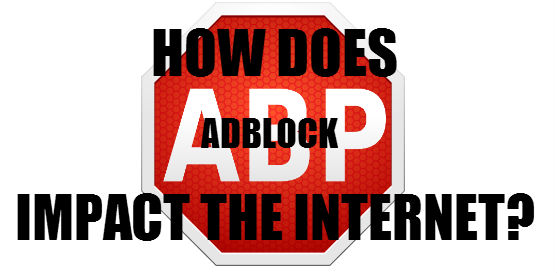
Some of your favourite websites depend on ad revenue income to remain online, so that they can keep serving you the website content that you enjoy on a daily basis. The issues with this are simple: users blocking ads on a website are benefiting from a website and using the website’s bandwidth free of charge.
Ad revenue can be made in a number of ways:
- PPC (Pay-per-click)
- PPV (Pay-per-view)
- PPA (Pay-per-action)
- Direct sponsor / Prepaid ad placement
PPC ads work by CPC (cost-per-click), so the website publishing the ad will receive a small amount each time an ad is clicked on their website. PPV is impression based and usually works by CPM (cost-per-mille) so websites will receive a small amount of money for every 1000 ad impressions, meaning every 1000 times that that ad is viewed. PPA ads give the publisher a small amount every time the ad converts (either to a sale or download or signup or whatever) and pays by CPA (cost-per-action). Advertisers who advertise on a website directly however often have an agreed price plan worked out with the website owner, paying for an agreed upon duration of time for their ad to be running in a specific spot. For example, they may pay £1000 a month directly to the website owner for their banner ad to continuously be displayed at the top of the website.
Below are some statistics on the usage of advertising technologies on the internet as of 22nd September 2014:
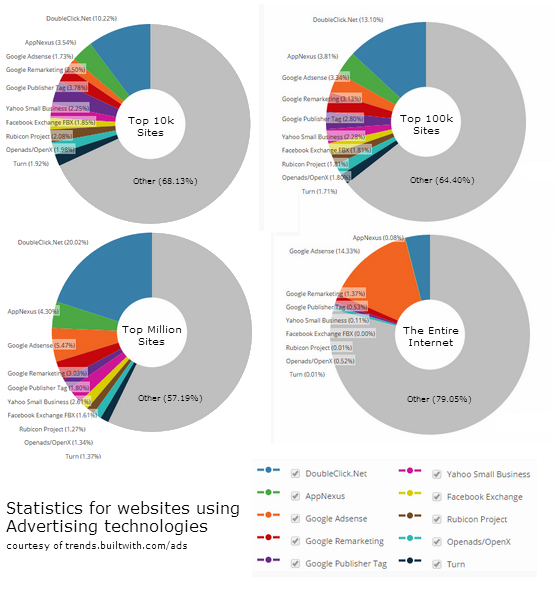
As we can see, a large majority of advertising technologies used are Google properties: Google Adsense; Google Remarketing; Google Publisher Tag; and DoubleClick.Net is a subsidiary of Google that develops and provides ad services. The greyed out “Other” category comprises of loads more lesser-known ad services used worldwide.
But just because the majority of internet users choose to advertise or publish advertisements through Google doesn’t mean that Google ads are necessarily the ads people are specifically looking to block when browsing. In fact, internet users have gotten very good at subconsciously ignoring ads that don’t appeal to them so long as they are unobtrusive – as Google ads tend to be.
Why do people block ads?
There are a whole number of reasons why some people would rather install an ad blocker than be advertised to, including:
- To avoid being bombarded with seizure-inducing, annoying or NSFW ads
- Because they know that they will not click on them anyway
- To speed up website loading times
- They do not want to help the website that they are visiting
- They do not trust the websites that they are visiting
The vast majority of ads do not interrupt the user’s browsing whatsoever. But those that do are the ones that leave that long lasting impression on the user and falsely affirm the negative reputation that ads have come to inherit.
For those internet users who suffer from a slow download speed, using ad blocker is a way to speed up website loading times as they do not have to load all those ad scripts. In fact, a lot of people who do have an excruciatingly slow internet speed disable a lot of onsite elements in order to browse the internet more comfortably.
But there are those who argue that they shouldn’t have to waste their bandwidth on ads, regardless of their broadband allowance. But then when you’re visiting a website via search engine results to view the main content, surely all of the website’s supplementary content (the navigation, sidebar, perhaps even the comments section) is a waste of your bandwidth too. After all, you’re not interested in browsing the website any further than that one particular article that you were searching for.
“But I never click on ads anyway…”
Some internet users generally as a rule just never click on ads. So why should they waste their bandwidth and lower their page load speed unnecessarily? Thing is, some ads are not always there expecting to be clicked. Some advertisers advertise solely for brand awareness. When you see a company’s logo everywhere you go, eventually you will start to recognise it. If you were to ever be in need of that company’s service or product in future, they quite possibly may be the first thing to come to mind once you’ve reached that initial Awareness Stage of the Buyer’s Journey. So a lot of ads aren’t actually targeting to your immediate need; they’re just looking for brand recognition.
But unlike Google ads, which are heavily regulated to avoid displaying malicious or offensive ads to users, the ads that really stand out to people and persuade them to start using an ad blocker are the infuriating pop ups and malicious/offensive ads. These ads tend to be part of more questionable ad networks that are less restricted in what advertisers can advertise on the network. But ad blockers do not discriminate by default…
A Better Way To Use Adblock
The most popular ad blocker browser extension is Adblock Plus who promote themselves as a tool for blocking all annoying ads, but supporting websites by not blocking unobtrusive ads by default. On Firefox, Adblock Plus is by far the most popular extension, boasting over 20 million users whereas the extension coming in at second place has a little less than 6 million. They state that they support websites by not blocking unobtrusive ads by default, but I haven’t seen that to be the case through my experience, and it does seem to block even Google’s text ads by default.
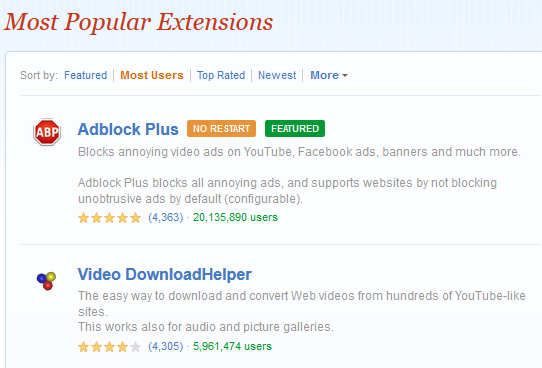
It doesn’t take much to reconfigure the settings though. Most people will install Adblock Plus and leave it running just the way they found it, completely forgetting that they even have it installed. But a couple simple reconfigurations in the settings, and you’ll be helping out all the websites you love whilst not supporting the ones that you don’t.
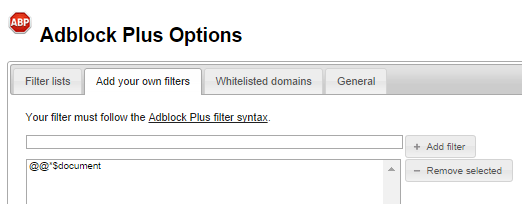
If you right-click the ABP icon in the top-right of your browser next to your address bar (or wherever you choose to locate your extension icons) and click Options, you are presented with an assortment of different settings that you can play around with. You can add filters and whitelist the websites that you want to support by viewing their ads. By clicking on Whitelisted domains, you are able to just add the domains of the websites that you want to enable ads for.
BUT. If you add your own filters, you can type @@*$document to disable Adblock Plus by default, so ads display on all websites. But what’s the point of that, you ask? There are a lot more websites out there that don’t irk me with ads than there are that do. But it’s not always just ads. If I’m visiting a website for research whose beliefs or whatever I don’t personally agree with and wouldn’t want to support (for example, researching a competitor or political website who I morally oppose), then I wouldn’t want them or their website to benefit financially from me browsing. (Even ad publishing websites that only display CPC ads: you being on that page, even without clicking an ad, contributes to their CTR and other figures that can have an effect on how much they are paid at the end of the month.)
The issue isn’t always with the ads but with the website. So by disabling websites as you go, Adblock Plus will remember your preference for that website every time that you return to it.
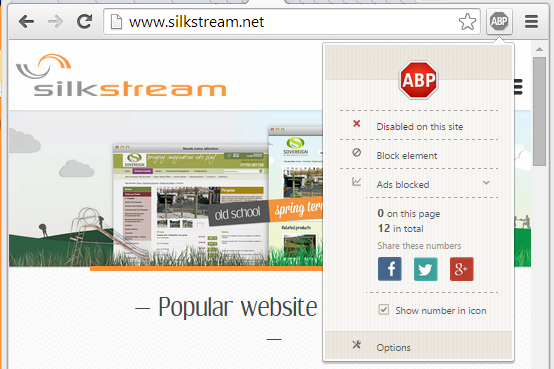
Silkstream don’t display ads, but if we did you could see how you have Adblock Plus configured for the Silkstream website here!
Supporting Websites By Disabling Adblock
Some websites publicly request directly on their website that their visitors disable their ad blocker and to view the “kind deed” as a sort of website donation so that they can keep paying for their server costs. TeamLiquid, a Starcraft 2 website, displays a banner of their own to adblock users in place of where the ad banner would be if they were not using adblock:

This is not against Google’s Terms of Service (why would it be?), however websites directly asking or inferring that users should click their ads are in violation of Google’s TOS and the websites do need to be reported. But sending a friendly message informing them, just in case they were simply not aware of this rule, would be much nicer than just reporting them to Google who may decide to ban them from Adsense, resulting in them losing their website’s only form of income.
Some websites like 4OD all out refuse to play their On Demand videos of TV shows unless you disable your adblock. They also appear to have a team monitoring for specific 4OD ad blockers. As soon as one is updated to work, they are very quick to update their own adblock blocker to prevent the browser extension from working. Websites like 4OD, that remove website functionality if you are using an adblock, usually work by detecting the effect of the adblock’s filters – not the presence of the adblock itself.
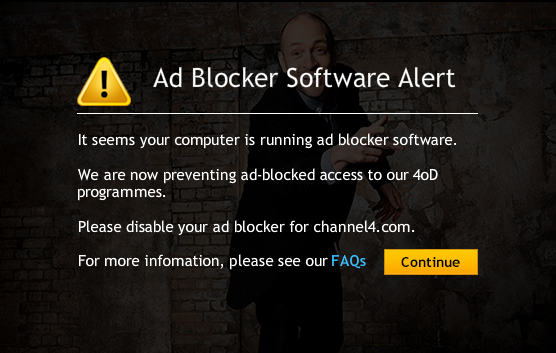
The Impact of Adblock on the Internet
Adblock contributes to a substantial loss of income for some websites that depend solely on ad revenue but, unless websites find additional ways of monetising their web properties, it is not something that they can easily prevent. It seems like websites with a loyal user base are more effective at convincing their adblock-using users to disable the adblock on their website. But if your ads are annoying, then users will not be persuaded to give up their adblock. So all website owners should ensure that ads are targeted to their users accurately and deliver a good user experience. The same way that children love targeted children’s TV ads as much as the kids TV shows that they feature around, the best ads are the ones that are contextually relevant to the webpage. It is up to the publisher then to ensure that the ads are both useful and relevant to the audience.
Have a look at how your Google Adsense campaign settings are set up, and look into your Google Analytics to get a clear idea of your website’s demographic, to see if you can better target the ads your website displays. This would benefit both you and your visitors. Or you can also explore alternative methods of monetisation, like putting certain content behind a paywall and offering a freemium service to your users, directly asking for website donations, opening a gift shop or accepting sponsored posts.
Read how Ello plans on monetising their social network without the use of ads!

